One of my favourite games is Dungeoneer by Thomas Denmark and published by Atlas Games, partly because of its carefully crafted ruleset, and partly because of its mysterious lore. Dungeoneer is sold as card decks, although it's actually also a board game, with some of the cards in the deck serving as board tiles. I own 5 Dungeoneer decks, and I'm reviewing them each. In this post, I'm looking at the characters of the Vault of the Fiends set.
For background about the world of Vault of the Fiends, disjointed though it may be, read my setting of Vault of the Fiends post.
Non-player characters
The dungeon that is the Vault of the Fiends is designed to kill intruders. There aren't many with names who dwell in the dungeon, but here are the few we know about, along with some other notable non-player characters (some of whom are also mentioned in other sets.)
Cerberak
The quest card Slay Cerberak depicts a winged insectoid fiend probably named Cerberak. The flavour text reads:
The hideous friends of Ramalith come in all forms.
That's friends not "fiends," which somewhat suggests that Cerberak is an intelligent creature rather than a pet or slave. It's unlikely that Cerberak is a highly successful experiment (he's not called the Son of Ramalith, for example.) Cerberak appears to be wholly unique among the fiends of the dungeon, so potentially Cerberak is a visitor from another plane.
Gwildor
The Holy Breastplace card says:
This holy breastplate was fashioned after the golden armour of Gwildor.
Gwildor was a respected, and possibly even deified, paladin. In the Haunted Woods of Malthorin set, the Potion of Invigoration flavour text says:
The high priests of Omnisus call this potion the tears of Yondara, the holy mother of Gwildor.
Omnisus is an important god of Tarnys, so if his high priests consider Yondara holy then she must be a significant figure, and so too would be her progeny.
Hala
The quest card Sunken Treasure says "Legends tell of the sacred boots of Hala, buried in a flooded chamber." We don't know who or what Hala is. She could be a famous but lost adventurer, or a mage, or it could be the name of a distant land famous for its magical footwear.
The boots are almost certainly magical, because acquiring them grants +2 Speed.
Ramalith
Ramalith is a powerful mage who uses both scientific laboratories and arcane magic to achieve his evil ends. He's probably from Yserion, and he is master of the dungeon in Vault of the Fiends.
Ramalith spends his time experimenting with magic to find new ways to create custom fiends (either in a test tube or by aberrant procreation) and teleport fiends from other worlds to Tarnys.
He has made powerful enemies, however.
The locals in the area hate him because his dangerous creations roam the countryside. He also takes prisoners and subjects them to unendurable torment, maybe by experimenting on them or maybe by using them as playthings for his monstrous menagerie. The card Ramalith bears the flavour text "You'll make a nice addition to my collection," so it seems that Ramalith does view his dungeon as something of a zoo or a trophy cabinet.
It also seems that Oriella, Queen of Dimensions and ruler of the Ethereal Void, is unhappy with Ramalith for meddling with time and space.
It's probable that the Eldritch Lords, in whatever form they exist (if they exist), would also be unhappy with Ramalith for potentially harnessing the soul of an Eldritch Lord as the motive force for a golem, as mentioned on the Enchanted Golem card.
Ramalith is not the target for any quest card in the set. However, destroying his laboratory and his creations, and generally foiling his plans, make up most of the quest cards.
Son of Ramalith
It seems unlikely (although not impossible, in a fantasy world containing Ramalith) that the Son of Ramalith is actually Ramalith's progeny. The flavour text on the Son of Ramalith card supposes that Ramalith may have mated with the Ancient One to produce it, but the fiend depicted bears no resemblance to anything human. It's possible that the card is intentionally overstating the relationship, in a kind of inversion of the Cholizar's Pet card, which depicts an abomination with flavour text that reveals it's actually her child (a demon is its father.)
The Melee and Magic rating for the Son of Ramalith is dependent on how much Peril is used to play the card. This high variability supports, to my mind at least, the experimental nature of the creature, as if it isn't something that was birthed but created, with stats that can be adjusted with a few alterations in dosage of magical formula during assembly. Whether the son of Ramalith is literally the son of the mage or just another experiment (or both), the reptilian fiend on the card is a potentially dangerous threat.
Oriella
Oriella is possibly a goddess or a universal power, also known as the Queen of Dimensions, and ruler of the Ethereal Void. She governs the use of the Ethereal Void in magic, and has the power to put a stop to transdimensional travel.
Omnisus
A god of Tarnys. Omnisus is mentioned in other Dungeoneer sets, but gets just one mention in Vault of the Fiends. The card Healing says Omnisus has granted the gift of healing," which for Omnisus is surprisingly unconditional.
Princess Penelope
A captive in Ramalith's dungeon, Princess Penelope is presumably nobility from a local royal family. The flavour text of Rescue Princess Penelope warns you "Don't hurt the cute, fuzzy little fiends," implying that the pricess may have made friends with either benign fiends that Ramalith has created for her (or created and lost interest in because they were too docile). Alternately, it's possible that Princess Penelope has a special skill with animals, and has befriended mundane mice who hav made their ways into the dungeon.
Prisoners
The quest card Free the Prisoners reveals that Ramalith keeps captives, although it doesn't say why. Whatever he is doing to them, the flavour text assures us that it's not good:
It is unimaginable what Ramalith's prisoners have experienced.
Player characters
There are 6 heroes included with the Vault of the Fiends set, and none of their cards have flavour text.
Grog Nordham, Human Beastmaster
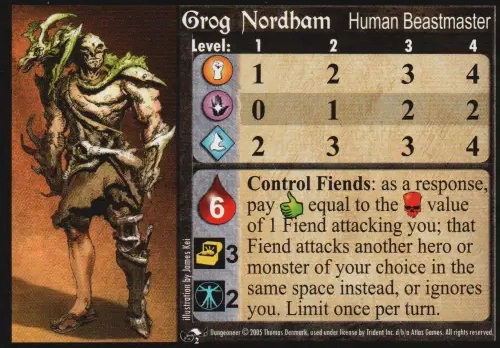
Grog has an affinity for, or possibly a magical power over, beasts. Significantly, that power extends to fiends, and he's able to redirect a fiend's attacks to another hero in the same space. He's strong and fast, with latent magic.
Hemp Ghostcaller, Ork Shaman
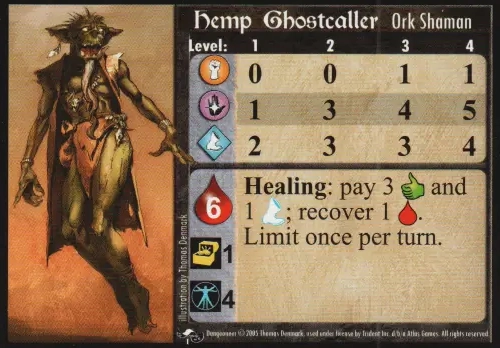
As far as I know (from my 5 sets), Hemp is the only Ork player character in Dungeoneer, and a classic "squishy" magic user. Hemp is highly magical, starting at 1 Magic but ramping up to 3 at Level 2. Melee is Hemp's lowest score at 0 until Level 3, after which it's just 1. To make up for the low Melee score, Hemp can heal once per turn (although it's rather expensive.)
Maluvius, Drakan Sentinel
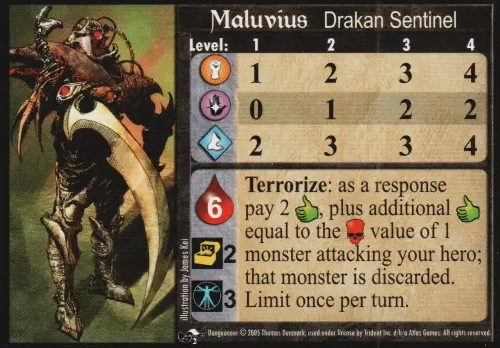
The character art for Maluvius is not by Thomas Denmark and, I must confess, it's completely unintelligible to me. When I look at it, I see a Thanoi from Dragonlance (basically walrusfolk.) I think it's meant to be a humanoid in a sort of steampunk deep-sea diving helmet, but I'm honestly not sure.
We know from the Dragons of the Forsaken desert set that Drakan are the people who inhabit Forlornia, a desert wasteland that was once a fertile region. The Drakan character in that set is similarly difficult to interpret, but again has a vague steampunk appearance.
Whatever a Drakan Sentinel is, it's powerful. Maluvius has the potential force a fiend to be discarded (given enough Glory.)
Nord Fimble, Gnome Illusionist
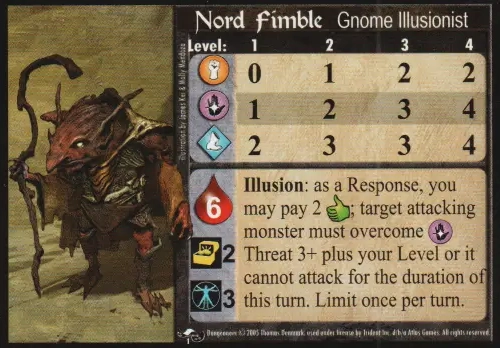
Possibly the most revealing card of all this set's character cards, Nord Fimble establishes what a gnome is in the Dungeoneer universe and it is nothing like the garden gnome out in your font lawn. Nord is a rat-like humanoid, red or brown and possibly furry, more like a goblin to my eyes than a traditional gnome.
Nord is a powerful mage and is featured on the Precision Arcana card with the flavour text "I may be small, but my arcane knowledge is great!" This is true only for the duration of that card, though, and Nord's Magic rating actually only starts at 1 and progresses steadily by 1 up to Level 4.
Nord is also on the Find Secret Door card, with flavour text that tells us something of gnomes in general:
Gnomes are particularly god at finding hidden places.
On the Hide in Shadows card, Nord is depicted hiding behind a crate, with the flavour text "Nord hide in shadows real good."
Nord Fimble is one of the player characters available in more than one set, which means you can play him in his Level 10 form. He appears in the Dungeoneer set Wrath of the Serpent Goddess in high level form.
Shara Quickblade, Elf Assassin
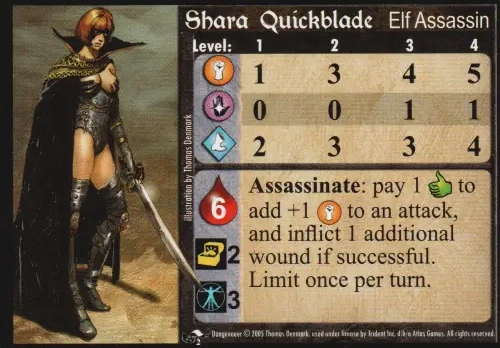
Shara Quickblade is a low magic (Magic 0 at Level 1 and Magic 1 at Level 4) martial character. She starts at Melee 1 but it ramps up to 3 by Level 2 and is 5 by Level 4. She's fast too, with Speed 2 at Level 1 and Speed 4 by Level 4. She's featured in the artwork of a few cards, some powerful (Strategic Mind) and some almost comical (the understated Nudge card.)
Shara Quickblade has the Assassinate ability too, which allows her to pay 1 Glory for +1 Melee to an attack, plus +1 damage upon success.
Like Nord Fimble, Shara Quickblade is one of the player characters available in more than one set, which means you can play her from level 1 all the way up to 7. She appears again in the Dungeoneer set Call of the Lich Lord as a Master Assassin.
Throngar, Dwarven Runecaster
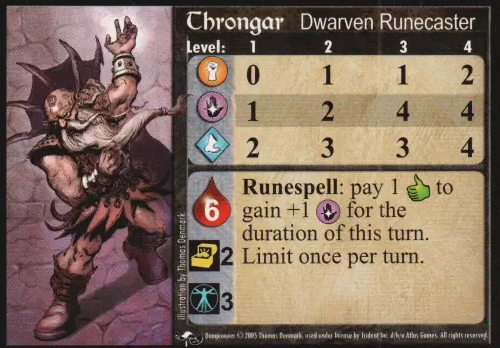
Throngar is a mage, and with the Runespell ability he can pay 1 Glory for +1 Magic once each turn. That's not a very expensive boost, and he ramps up to 4 Magic at Level 3, so he finishes strong. This comes at the expense of his melee rating, which starts at 0, stays at 1 for Level 2 to 3, and only reaches 2 at Level 4.
He's a rare playable dwarven character, which suggests that either dwarves are not commonly dungeon adventurers or that there are few dwarves left in the world. We don't know which, but it's possibly notable that dwarves are spoken of in the past tense in Realm of the Ice Witch.
Throngar is featured on a few cards, including Eldritch Mastery, Fiend Targeter, and Dimensional Snare.
Fiends
A dungeon is nothing without its monsters, and the Dungeoneer set Vault of the Fiends is full of them. For most creatures, I usually assume a name refers to a category of fiend, not a singular specific fiend. Itt's possible for a card to come up more than once during a game, but then again maybe it's a specific fiend that gets resurrected when necessary.
- Armor Golem: A golem, proably made of armor. The card Dismantle Armor Golem only shows a glove from the golem, but it's likely that the golem is made from a human-sized suit of armor (possibly obtained from a fallen knight who ventured into the dungeon?) The flavour text says "The discrete parts of the Armor Golem could make a formidable weapon," so it's unlikely that the golem is so huge that its parts couldn't be repurposed by humans, dwarves, and even a gnome.
- Dark Ratling: An aberrant or mutated rat. It's classified mechanically as a Vermin (not a Fiend) so Ramalith is probably not responsible for its creation. It is likely a native species of Tarnys.
- Enchanted Golem: An artificial, constructed fiend possibly powered by the enslaved soul of an Eldritch Lord. The card's flavour text is a question about whether Ramalith powers this golem with the soul of an Eldritch Lord, so it's possible that this is spurious. Cards like Free the Prisoners and Unsavory Bargain suggest that Ramalith is able to extract souls of living creatures, so it's possible that he powers golems with the souls of his prisoners, and not Eldritch Lords.
- Flawed Experiment: A walking brain, with teeth. More than one fiend is depicted in the card art, so it's likely that the Flawed Experiment card is meant to refer to any number of experiments gone wrong, and that the flavour text refers to only one of them.
- Gelatinous Blob: Probably more a trap than a conscious creature, a Gelatinous Blob "ingests" objects and creatures probably in a similar way quicksand sucks items into it. It does cause damage, and the loss of loot, so it may actually have a digestive system, or it may simply be resistant to extrication that it hurts to struggle free.
- Heinous Fiend: A jumble of tentactles, mandibles, and eyes, the heinous fiend is the target of the quest card Slay Heinous Fiend. It's probably a unique fiend (the card isn't "Slay a heinous fiend", after all), and has a certain appearance of an experiment gone wrong (certainly it's not as refined in design as an impaloraptor or a golem.)
- Impaloraptor: An ostrich-like reptilian fiend "made for one thingk: pecking eyeballs out." This flavour text is reinforced on the Fiendish Rager card, which depicts 2 impaloraptors and the flavour text "We'll rip your eye out!!!"
- Iron Golem: An artificial, constructed fiend made of iron. It's unclear whether this is the same thing as an Enchanted Golem but in most myths, all golems are enchanted by definition. It's probable that an Iron Golem is powered by an enslaved soul (possibly of an Eldritch Lord, but possibly just a prisoner.)
- Janguba: A great hulking, slobbering reptilian behemoth of enormous strength, Janguba can slam scrawny heroes to their deaths. In fact, a successful attack from Janguba sends a hero into an adjoining space. It's unclear whether "Janguba" is the name of the creature type or its given name. If it's the creature type, then it's a pluralised singular: There can be a single Janguba or a herd of Janguba.
- Murk Dragon: We know there are ice dragons in the north, so a murk dragon is likely a native creature of Tarnys. According to the flavour text, "Murk dragons smell as awful as they look." At a Peril cost of 5, a murk dragon is also as dangerous as it costs.
- Shrieking Demon Worm: Not a fiend, but a demon, almost certainly from another plane of existence, the shrieking demon worm deals damage through magical singing as well as through physical attacks. Its Magic rating is only 3 (compared to 4 Melee) but a successful Magic attack causes +3 Peril.
- Slithering Vines: Largely indiscriminate in who it attacks, Slithering Vines are more a trap than a creature. This is true mechanically (when played, it effects all heroes in the space), and probably in lore as well. Presumably regular inhabitants of the dungeon know to avoid, or how to appease, the vines. Intruders do not, and are attacked, take damage, and then dragged to an adjacent space.
- Stun Ooze: Largely indiscriminate in who it attacks, a stun ooze is more a trap than a creature. This is true mechanically (when played, it effects all heroes in the space), and probably in lore as well. It probably doesn't intentionally attack anything, but instead is a mindless, sticky (according to flavour text), toxic substance that regular denizens of the dungeon know to avoid. Intruders must learn the hard way.
- Tortured Soul: Based on the artwork, probably an experiment gone wrong. A humanoid mass of skeleton and tendrils, a tortured soul is higher in Magic than Melee, so it may be something reanimated or teleported from another plane. I've always assumed that this is the eventual state of most of Ramalith's prisoners.
- Two-Tail: A reptilian fiend not vaguely resembling a Tyrannosaurus Rex, but with 2 stubby tails. Its flavour text says that they're "indecisive but dangerous once they make up their minds." It almost sounds like the text was written for a creature called Two-Heads, but the creature got changed at the last minute, but maybe the flavour text is just a non sequitur.
- Vault Guardian: A fiend with a severely conical skull and oversized and toothy mouth, presumably serving as the bouncer for the dungeon.
Ramalith score card
Vault of the Fiends is a great Dungeoneer set, and it manages to tell a surprisingly distinctive, and complex, story about a specific and deadly dungeon. It's clear that Ramalith is using arcana as well as mechanisms to carry out his experiments. The quest cards Burn the Dark Tome and Destroy Infernal Machine and Destroy Ramalith's Laboratory nicely confirm this combination. I think it's fair to say that probably Ramalith is better at mechanical invention than at biomancy. He apparently has no failed golem experiments, but his biological creations are mostly disasters. Most of the cohesive lifeforms in his dungeon appear to have been stoled from other planes or captured from Tarnys itself. It's likely that the local residents in the region were able to ignore him when he was tinkering with magical clockwork men, but decided to put a call out for his removal once he started to kidnap their family members, and pollute the region with aberrant monsters.
This is a good Dungeoneer set. If you can get a copy, it's well worth it!
Header and card image copyright by Thomas Denmark and Atlas Games, and used exclusively as reference.